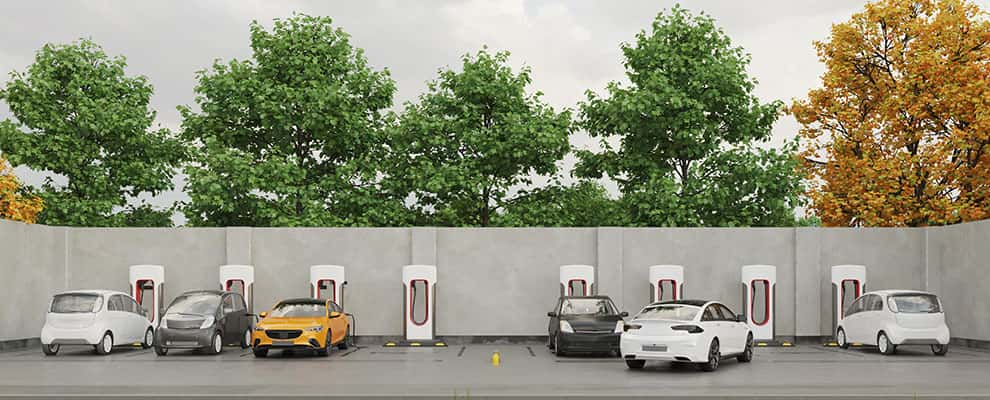Electric vehicles (EVs) are the future of personal transportation. Countries worldwide have committed to reducing greenhouse gas emissions, and EVs have the potential to make a significant impact in that regard. With many countries providing subsidies for EVs, the automotive industry has been dedicating more resources to designing and producing new electric models. However, this has ripple effects on the entire industry. How can your company adapt to this changing environment?

How Will the Automotive Industry Adapt to Electrification?
EVs Continue to Trend Up
Even though several auto manufacturers have recently scaled back EV production due to drops in demand, this is only a short-term phenomenon. With interest rates high, many people are postponing their car purchases. However, the long-term trend is clear: EVs will continue to be the focus of automotive manufacturing going forward. Projections estimate over 30% growth through 2030. Don’t let temporary disruptions in the market distract your business from the long-term future.
In order for your company to remain competitive in the future, you need to adapt your business to the growing demand for EVs. EVs require new processes and technology compared to traditional internal-combustion engine (ICE) vehicles. Although ICE cars remain popular and will likely continue to be produced for decades, their share of the market will only continue to shrink. Don’t be left behind; get ready for the electric future. Nevertheless, the road ahead has a few bumps.
Electrification Presents Several Challenges
Shifting towards more EV production means new challenges for automotive manufacturers and everyone else down the line. Some of these issues are simply growing pains; ICE vehicles have been in production for a century, while EVs have only really taken off in earnest in the last decade. However, some problems go beyond the manufacturer’s scope, such as national infrastructure. Furthermore, from a governmental perspective, EVs alone won’t result in significant environmental impact without clean energy on the grid.
Consider how you may be able to position your business to take advantage of some of these issues and provide unique solutions. Many of the tools that benefit EV production in the automotive industry can also be used elsewhere to provide value. Creative businesses will find ways to use their technology in other fields, like Tesla using their battery technology for residential and commercial energy storage. Your company can provide multi-faceted solutions that yield greater profits too.
Battery Technology Obstacles
Electric vehicles need large capacity batteries to provide the range that customers want. Given the weight of these battery packs, they’ve become the primary focus of electrical engineers in automotive companies worldwide. Any solution that reduces weight without sacrificing energy density will likely be well received by the industry. University researchers have experimented with several new designs, but few have been brought to mass production. Could your company lead the cutting edge of battery manufacturing?
Battery safety is another major concern, as a fault can lead to runaway fires, which are one of the biggest issues with EV vehicles. These fires can take upwards of 20,000 gallons of water to put out and endanger cars, homes, and businesses nearby.
Investing in smart test bed technology can help your business test out battery designs and ensure their compliance with safety standards. By testing in both simulated and real-world environments using automation, you can test more designs in less time and determine the best models to bring to production.
Supply Chain Changes
An EV supply chain differs considerably from that of an ICE vehicle. The entire drivetrain is different, since EVs don’t have multi-speed transmissions. Electric motors don’t require the complex cooling loops that ICE vehicles do. Even the brakes work differently, since EVs look to leverage regenerative braking for additional energy. If your company is focused on producing components whose demand will fall in the future, shift your focus to components that will be necessary for EVs going forward.
EVs go hand-in-hand with technology. Automotive engineers and designers have taken advantage of the opportunity to completely rethink how cars should function. Self-driving features, for example, are practically synonymous with EVs. These systems require lots of sensors and cameras to function. Those components will be indispensable going forward. Similarly, power management devices like inverters and flow meters will become standard on all EVs.
New Designs Mean New Opportunities
Since EVs have such different internal components, the entire design of the vehicle can be called into question. The hood no longer needs to contain a massive engine, so it could instead serve as storage. Cabin interiors can be expanded. This may call for more entertainment or comfort features for passengers, further impacting supply chains. However, other companies are taking advantage of the reduced component footprint to produce smaller EVs.
For instance, 3-wheel EVs have seen a resurgence in recent years as they can be lighter and sidestep certain taxes that apply to traditional 4-wheel vehicles. Could your company identify opportunities to design and produce components for this emerging segment? Electric bikes and other small vehicles are growing in popularity as well. Don’t ignore these smaller market segments that are poised to grow.
Infrastructure Needs
EVs can only go as far as the grid allows. That’s why it’s also important to invest in charging stations and cleaner energy infrastructure nationwide. Tesla took the lead in this as they were a pioneer in the EV field and realized that without a charging network, their sales would suffer. Can your company help build charging infrastructure, or add to the green energy on the grid to take advantage of the increased demand for electricity that EVs generate?
Whether you want to manufacture the latest EV components or research on new battery testing technologies, you need to make sure your automotive company is ready for the future. A digital transformation will put you ahead of other businesses and make your company more responsive to change. Contact SAAB RDS to learn more about how we can help your business grow in the ever-changing automotive industry.
